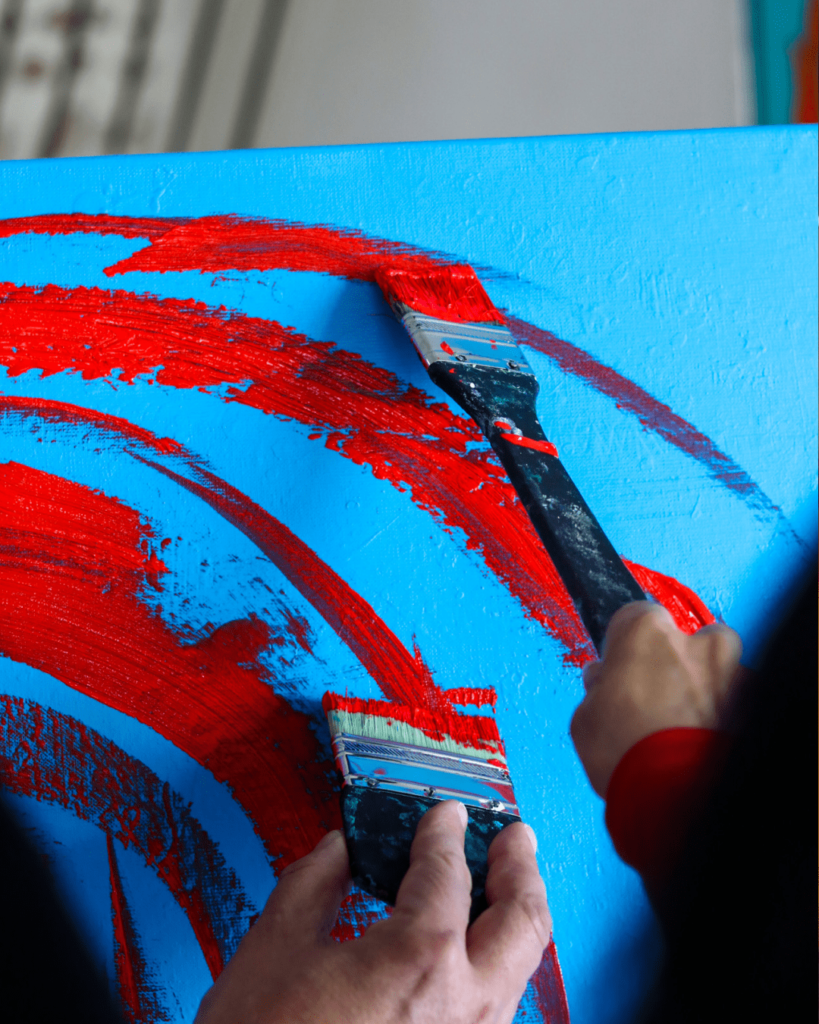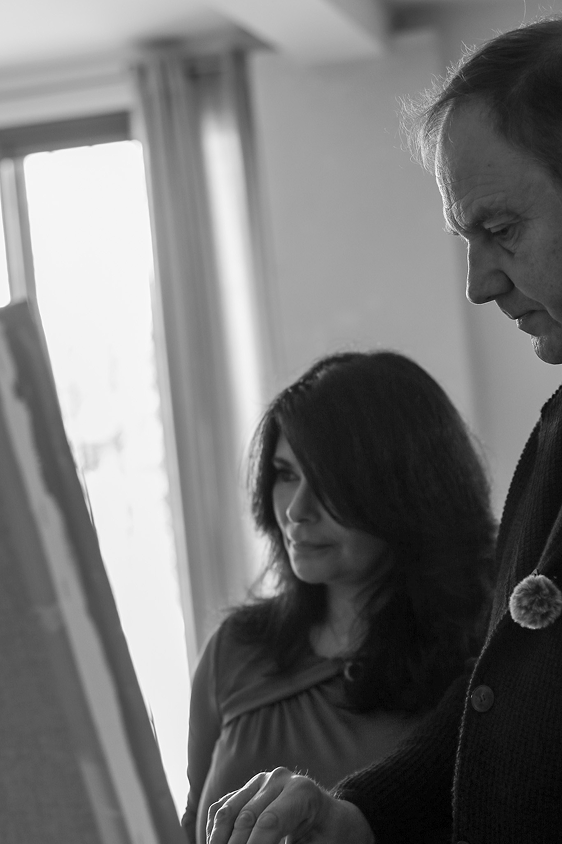In the art studio of COHA, the creative process comes alive by a silent dialogue between material and intention. The art work starts by establishing generous surfaces offering a world of textures.
Then, in a four-handed process, circles emerge playing with both light and color.
Veronica Angie Cornejo Llosa and Klaus Rune Hansen craft these infinite forms with a rigorous methodology and instinctive sensitivity.
Through textures and multiple layers each gesture offer a unique harmony. Craftsmanship and creativity intertwine with a multicultural approach.
Thank’s to this harmony two unique collections were created : Between light and darkness, whose canvases play on the contrasts of black and white, and CHROMA, a series of art works retaining the circle as a main symbol, while exploring the entire chromatic palette of the rainbow.
Interview with COHA in Nîmes, in their atelier.

What was the starting point for the COHA art collections?
Klaus: It started as an idea of creating a multicultural art collection. Art works where, ultimately, Peru and Denmark meet in a single sphere, since it’s a place where several cultures come together, accept, tolerate, and inspire each other.
It’s true that Peru is very different from Denmark. Denmark represents the more minimalist side, and Peru…
Veronica: Lots of colors, like rainbows !
K: But the two countries have one thing in common: humanity and sense of community. These two cultures, very different, find themselves in a circle, and that’s why the artistic trigger was to work exclusively with the shape of the circle.
The circle is a recurring form in your artwork. Which role does it play in this art collection in particular?
V: We decided to work with the circle because it has been used by humans since the beginning. It has so many meanings! It has no beginning nor end and it is constantly moving. There is the part we see and the part we don’t. It also represents the passing of time. We wanted to work with the circle as a message.
K: A spiritual message. It’s true that there is what we see, the “homogeneous” side of the circle, but there is also what we don’t see: our own abyss, the void. This invisible part is perhaps the most inspiring part.
How did the creative process evolve? Did you work differently compared to what you did in your previous collections?
K: Our approach and our artistic values remain identical and unique. That is to say, we always begin with a lot of flat tints, layers of paint, and a lot of textures.
Ultimately, it’s these textures that bring depth and multiple interpretations to our artworks. Then come the brushes and circles.

How did the creative process evolve? Did you work differently compared to what you did in your previous collections?
K: Our approach and our artistic values remain identical and unique. That is to say, we always begin with a lot of flat tints, layers of paint, and a lot of textures. Ultimately, it’s these textures that bring depth and multiple interpretations to our artworks. Then come the brushes and circles.
V: Right, in the middle of the canvases, the circles emerge, each time in a different way. It varies all the time. A creation that will never result in two identical canvases. It depends on the color, the depth, and the flat tints that are applied beforehand, which bring a total different texture.
K: That’s absolutely it. The evocative aspect and the very free interpretation of our canvases are very important to us.
The CHROMA collection is described as a celebration of colors and their connection to life, nature, and time. Can you tell us more about your philosophical approach?
K: The CHROMA collection is forever rooted in the same artistic process, meaning textures, reliefs, depth, optical effects, and circles… But with lots of color! For us, colors represent our connection to present time. For us, the present is a “present”. We wanted to reconnect with the present moment through color, since it’s the only mindful moment. The past is in the past, the future did not happen yet, so the present is necessarily the most interesting part in life. We find that colors evoke emotions.
V: Yes, our colors do translate so many different messages. It also depends on the shape of the circle. Sometimes we create two circles at the same time, sometimes there’s only one on the canvas.

How does this collection interact with your previous creations?
K: The CHROMA collection interacts in a very intense way with all our art collections. The previous collection, “Between light and darkness,” has the same approach. It’s about the duality between light and darkness, because we believe that we don’t become luminous by looking at the light but by crossing our own darkness.
The CHROMA art collection is focused on the present moment, so much thanks to the emotion of the colors, which isn’t necessarily found in the previous collection.
How does this collection interact with your previous creations? How would you like art collectors to perceive CHROMA? What emotions do you hope to evoke?
K: Through optical effects, reliefs, and textures, we hope our art collectors will travel. Our art works can evoke all kinds of emotions as joy, astonishment and memories… It’s very personal!
V: Yes, it’s a bit like the clouds that emerge freely in the sky. Circles can inspire us, we can see different things in them, depending on a personal approach. Two people looking at the same paintings will see different things. And it’s incredible for us to be able to bring everyone a personal imagination by looking at our works.
K: So we wish you “Bon voyage”!
The between light and darkness and CHROMA art collections are currently exhibited in exceptional locations such as the prestigious Hôtel Imperator in Nîmes, at the Prestaart Gallery in Uzès and Biarritz, and at Galerie 28 in Reims.

